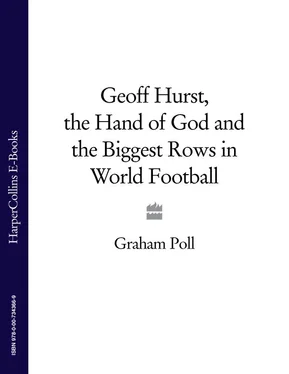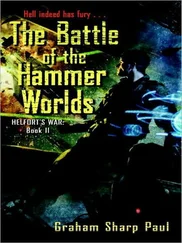He had his language difficulties when he was on foreign trips. On one occasion, at a match in Macedonia, the assessor was German and the officials were English. They included Dave, plus Mike Dean and Steve Dunn, who are big mates of mine. One of them asked the assessor his profession. He said, ‘I am ein doctair. I work with children. I am a paedi…paedi…’
As he struggled for the English word paediatrician, Dave tried to help out. ‘Paedophile?’ he offered, unthinkingly. Steve and Mike fell off their chairs laughing.
THE Mendes-Carroll goal (at Old Trafford on 4 January 2005) was such a blatantly wrong decision that referee Mark Clattenburg and assistant Rob Lewis beat themselves up about it. I spoke to Mark very soon afterwards and told him it wasn’t his fault and that nobody blamed him, but he was very upset because it was so clearly a goal.
Interestingly, though, at the time, Sky television’s commentators were not sure until they’d seen a replay. That is what often happens. Once we’ve all seen a dozen replays of an incident, we convince ourselves that what happened was obvious. Mark and Rob didn’t have any replays and had to go on what they’d seen at the time. The problem was that Rob didn’t give himself a chance of seeing anything much. He went into sprint mode, belting along the line to try to get back closer to the goal, and his head went down as he ran. It is easy to be critical with hindsight, but instead of racing back quite so frantically, Rob should have concentrated on the flight of the ball. So I think there is a good learning point from the Mendes-Carroll goal. It is that there are times when, as a referee or assistant, you have to accept that you must sacrifice proximity for viewing angle.
You have to keep an awareness of what is going on and what might be about to happen, and so you will notice good referees sometimes stop running forwards and take a step to one side to get a better angle. Similarly, an assistant should cover the ground as quickly as possible but while maintaining a good view. The assistant’s two main functions are to watch for offsides and to indicate when the ball goes out of play. As soon as Mendes hit his shot, there was no possibility of an offside and so Rob could and should have concentrated on ‘ball out of play’. With hindsight he knows he should have focused on the ball and the possibility that it would go into the goal.
I HAVE my own reason for remembering the name of the ‘Russian’ linesman, Tofik Bakhramov. As I have explained, he was really from Azerbaijan. The top stadium in that country is named after him. I refereed my first full international match there on 2 April 1997 (not, as some of you might imagine, the day before). I remember clearly that there was a sign showing a picture of a Kalashnikov with a cross through it, instructing everyone to leave rifles outside the stadium. You don’t see that in this country. Not since Millwall moved from the old Den.
I remember clearly that my match in the Tofik Bakhramov Stadium was a World Cup qualifier between Azerbaijan and Finland, and that the home side lost 2-1. What I don’t remember with any clarity is the hospitality afterwards, because instead of the few beers we were hoping for, the officials were given double shots of vodka.
Our hosts kept toasting us. Me and Steve Dunn (who was my Fourth Official again) kept replying to the toasts. Every time we did so, our glasses were refilled. After about 15 double vodkas, we realized that they wouldn’t stop toasting us until we stopped toasting them. By then we could barely walk.
Finland had won the match. If Azerbaijan had won, the toasting would never have stopped. We’d still be there knocking back the doubles. But then all Englishmen should be happy to raise a glass to Bakhramov, the man whose decision won us the World Cup.
THE ‘Russian’ linesman and referee Gottfried Dienst are well remembered, but who was the other linesman? He was Karol Galba, from what was then known as Czechoslovakia. He had refereed one match at the 1962 World Cup and went on to be the first president of the UEFA referees’ committee. In 2006, when the new Wembley stadium was being built, a ceremony was held on the pitch to mark the fortieth anniversary of the 1966 Final. Galba, the only surviving match official, attended, along with players from both sides.
2 Zidane Heads for the Dressing Room
THE MATCH
Was video evidence used to ‘convict’ the world’s greatest player in the world’s biggest fixture? That is the question I find myself asking the more I think about the 2006 World Cup Final.
The best player in the world? That was Zinedine Zidane. He’d won that title three times. He also won the World Cup with France, in Paris in 1998, and the European Championship two years later. He helped Juventus to two successive European Champions League finals and became the world’s most expensive player when he joined Real Madrid for 76 million euros. He scored the winning goal when the Spanish club won the Champions League. It was a remarkable career and it was to have an extraordinary conclusion.
In May 2006 he announced that he would retire after that year’s World Cup. So, when his beloved France reached the Final, it meant that the finest footballer on the planet was going to play his last competitive match in the globe’s biggest game. Nobody of his stature had ever chosen such a prestigious stage for his last bow. But, on the day, he made his exit as the villain, sent off for violent conduct. What an incredible story.
Yet is the full story even more intriguing? Like many others in refereeing circles, I cannot help wondering whether the officials used video technology against Zidane in Berlin’s Olympiastadion on 9 July 2006. If I had been the referee or the Fourth Official in those precise circumstances, then I would have wanted to get it right. And if that meant using a TV replay to check what had happened, so be it. Did the men in charge of the match do that? Has technology already been used in the world’s most important fixture?
What we can say for certain is that if ‘Zizou’ had been able to control his temper as well as he could control a football then none of this would be an issue. If he had been able to keep his head, instead of using it as a weapon, he might well have provided a much more fitting finish to his peerless career. He was the captain of France and there is a real possibility that he could have completed his playing days by lifting the World Cup. Instead, the last sight of him as a professional footballer was as he walked past the trophy on his way back to the dressing room after being sent off.
The 2006 World Cup Final pitched France against Italy and the two players who were to feature later in the most controversial confrontation each scored in the first 20 minutes. In fact, those two men, Zidane and Marco Materazzi, were both involved in the first goal, after seven minutes. It was Materazzi who fouled France’s Florent Malouda (although there was only the most minimal contact) and it was Zidane who converted the penalty to put France ahead.
Zidane being Zidane, the penalty was a bit special. As goalkeeper Gianluigi Buffon sprawled to his right, expecting a normal, hard shot, Zidane chipped the ball and sent it forwards and upwards in a slow parabola. Buffon was already on the floor long before the ball lazily clipped the underside of the bar and bounced down. He clambered up, turned around, and grabbed the ball but there was no need for an Azerbaijani assistant referee to decide that it had clearly crossed the line.
Читать дальше












